Mata Mansa Devi Mandir
Mata Mansa Devi is a Hindu temple dedicated to goddess Mansa Devi, a form of Shakti, in the Panchkula district of Haryana state in India. The temple complex is spread of 100 acres (0.40 km2) of the Shivalik foothills in the village of Bilaspur, near Sector 13 (earlier known as Mani Majra) of Chandigarh, and Panchkula, 10 km from Chandi Mandir, another noted Devi shrine in the region, both just outside Chandigarh.[1][2][3]
| Mata Mansa Devi Mandir | |
|---|---|
| Religion | |
| Affiliation | Hinduism |
| District | Panchkula |
| Deity | Manasa Devi |
| Festivals | Navratri |
| Governing body | Shri Mata Mansa Devi Shrine Board |
| Location | |
| State | Haryana |
| Country | India |
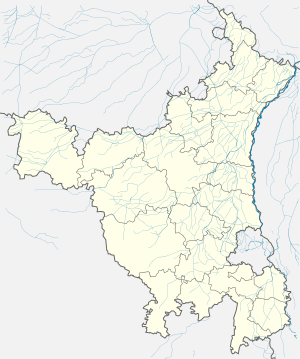 Location in Haryana  Mata Mansa Devi Mandir (India) | |
| Geographic coordinates | 30°45′55″N 76°49′37″E |
| Architecture | |
| Type | Hindu temple architecture |
| Creator | Maharaja Gopal Singh of Mani Majra |
| Completed | 1811-1815 A.D. |
| Website | |
It is one of the prominent Shakti temples of North India involving 7 goddesses, namely Mata Mansa Devi, Naina Devi, Jawalamukhi, Chintpurni, Brajeshwari, Chamunda Devi and Jayanti Devi. Thousands of devotees visit the shrine from various parts of the country, and especially during the Navratra mela, this number rises to lakhs every day for the nine auspicious days.
History
There are 3 temples in the complex and main temple is the oldest. Maharaja Gopal Das Singh of Mani Majra, who was enthroned in 1783, constructed the present main temple of Shri Mansa Devi, which is situated on the Shivalik foothills in village Bilaspur, Tehsil and District Panchkula, during the period 1811–1815. At a distance of 200 meters from the main temple is the Patiala Shivalaya temple which was constructed by Karam Singh, a Jat Sikh, the then Maharaja of Patiala in the year 1840. This temple had the patronage of Manimajra Princely State.[4] There are 38 panels of wall paintings as well as floral designs painted on the ceiling and arches leading to the temple, which according to an inscription were painted by Anged in Vikram Samvat 1870 (813 CE).[5]
After the merger of Princely states into PEPSU the Patronage of State Govt. ended and the temples remained neglected. The Raja of Manimajra then appointed pujari as ‘khidmatuzar’ to serve this temple whose duty was to worship the deity of the temple.
After the merger of princely State into PEPSU these pujaris became independent in the matter of controlling and managing the affairs of the temple and the land attached to the temple. They could neither maintain this temple nor provide necessary facilities to the visiting devotees and thus the condition of the temple deteriorated day by day. So much so that there were no proper arrangements for pilgrims visiting the temple during Navaratra melas. As a result, the Government of Haryana took over the temple and set up the Shri Mata Mansa Devi Shrine Board (SMMDSB) Panchkula trust to manage the temple. The complex was in awfully neglected condition till the establishment of the Board.
Temple management
The temple complex and its environment are presently looked after by Shri Mata Mansa Devi Shrine Board (SMMDSB) Panchkula which is a trust. In view of the popularity of the temple for its mythological and historical significance and also for fulfilling the wishes of the lakhs of devotees thronging to the complex, the Government of Haryana by an enactment (Haryana Act No. 14 of 1991) christened as Shri Mata Mansa Devi Shrine Act 1991 took over the control of this temple to provide for better infrastructure development, management, administration and governance of Shri Mata Mansa Devi Shrine and its endowments including lands and buildings attached to the Shrine. A Shrine Board with Chief Minister of Haryana as Chairman was constituted for running of the Temple and preserving the heritage of the region.
Navratra Melas
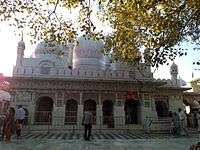
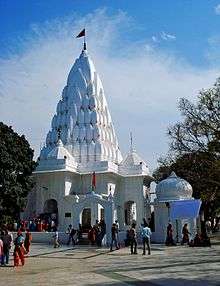
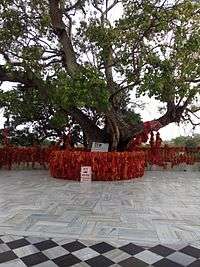
Navratra festival is celebrated in the mandir for nine days. Twice in a year millions of devotees visit the temple. Shardiya Navratra mela are organized at the shrine complex during Chaitra and Ashvin months. Every year two Navratra melas are organised in the month of Ashvin (Shardiya, Sharad or Winter Navratra) and other in the month of Chaitra, Spring Navratra by the Shrine Board.
Lakhs of devotees pay obeisance during the Navratra mela held in Ashvin and Chaitra and temples remain open throughout the day. These melas are of 9 days duration each time and concludes on the 9th day. The shrine Board makes elaborate arrangements for the comfortable stay and darshan of the devotees. The board makes arrangements for the provision of Chhowldari, tented accommodation, durries, blankets, temporary toilets, temporary dispensaries, mela police post and lines.
During the mela, Duty Magistrates and Nodal Officers are appointed to look after the devotees and smooth conduct of the mela. On the 7th and 8th day of Navratras, the temples of Shrine Complex are closed only for two hours during the night for cleaning maintenance of the temples. For the rest of Navratras, the temples remain open for darshan from 5 a.m. to 10 p.m.[6][7][8]
Transport
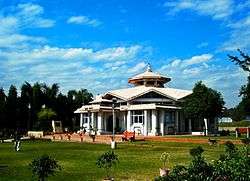
Located at a distance of about 10 km from the Chandigarh bus terminus and 4 km from the Panchkula bus terminus, the Mansa Devi temple can be reached by local buses
Chandigarh Transport Undertaking and Haryana Roadways supply special buses during the Navratra fair. There are daily flights operated by private airlines to Chandigarh. Since it is a popular travel circuit, bookings ought to be made well in advance. Chandigarh is the ideal place to start off if intending to visit the temple. If traveling by train, Chandigarh is the nearest rail head for those heading to Mata Mansa Devi. It is situated on the Chandigarh–Kalka rail line.
- Nearest rail head: Chandigarh
- Nearest airport: Chandigarh
Other Mansa Devi temples
- Mansa Bari, Kolkata
- Mansa Devi Temple, Bilwa Parvat, Haridwar[9]
- Mansa Devi Temple, Alwar, Rajasthan
- Mansa Devi Temple, Sangrur, Punjab
- Shri Mansa Mata Mandir, Sikar, Rajasthan
- Mansa Devi Temple, Narela, Delhi
- Mansa Devi Temple, Sitamarhi, Bihar
- Maa Mansa Devi Mandir, Mathura, Uttar Pradesh
- Mansa Devi Temple, Mukkamala[10], West Godavari, Andhra Pradesh
- Mansa Devi Temple, Naidupeta, Nellore , Andhra Pradesh
- Mansa Devi Temple, Tilaru, Srikakulam , Andhra Pradesh
- Mansa Devi Temple, Dornipadu, Kurnool , Andhra Pradesh
- Mansa Devi Temple, Kanumalapalle, kadapa , Andhra Pradesh
- Mansa Devi Temple, Chinadugam, Srikakulam , Andhra Pradesh
- Mansa Devi Temple, Kurnool, Andhra Pradesh
- Mansa Devi Temple, Nellore, Andhra Pradesh
- Mansa Devi Temple, Thurpu Rompidodla, Nellore , Andhra Pradesh
- Mansa Devi Temple, Vadluru, West Godavari , Andhra Pradesh
See also
- List of India cave temples
- Cave research in India
- List of Caves in India
- List of rock-cut temples in India
- Indian rock-cut architecture
- List of colossal sculpture in situ
- List of Monuments of National Importance in Haryana
- List of State Protected Monuments in Haryana
- List of Indus Valley Civilization sites in Haryana
- List of National Parks & Wildlife Sanctuaries of Haryana, India
- Haryana Tourism
References
- "History". Archived from the original on 9 June 2009. Retrieved 1 July 2009.
- Mansa Devi Contemporary Hinduism: ritual, culture, and practice, by Robin Rinehart. Publisher ABC-CLIO, 2004. ISBN 1-57607-905-8. Page 83.
- Mansa Devi temple to get wall cover The Times of India, 18 June 2009.
- Haryana Samvad Archived 29 November 2018 at the Wayback Machine, Oct 2018, p39.
- Haryana Gazateer, Revennue Dept of Haryana, Capter-V.
- Thousands throng Mansa Devi shrine Indian Express, 28 March 2009.
- Thousands of devotees thronged the Mansa Devi shrine on the first day of the nine-day ‘Chaitra Navratra Mela’... Indian Express, 20 March 2007.
- Lakhs attend Navratra fair Indian Express, 20 March 1999.
- Mansa Devi temple
- Mukkamala, West Godavari district
External links
Maa_Mansa_Devi_,mandir_(khuntaila_patti) Mathura Uattarpradesh